
Another day, another ’70s cabin cruiser. As is often the case, this one, a ’77 Eldo on Seattle Craigslist (Re: the location? No comment) was posted on Finding Future Classic Cars on FB.
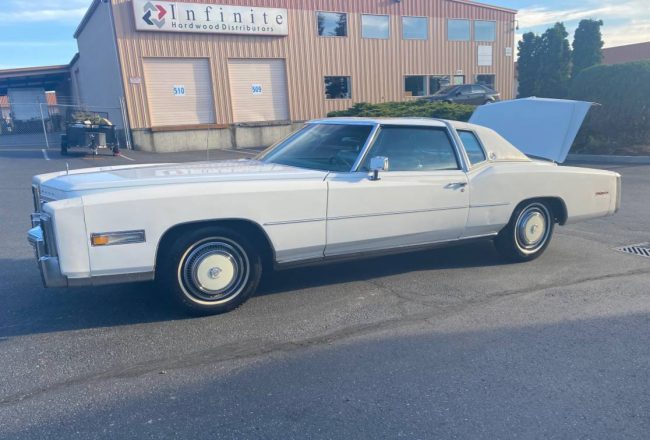
I’ve always loved the 1970s Cadillac Fleetwood Eldorados. They were so huge, so opulent, so unnecessary. And yet, so compelling. While my ultimate Eldo is, depending on the day, a silver-blue ’71 convertible or triple yellow ’78 Biarritz coupe.
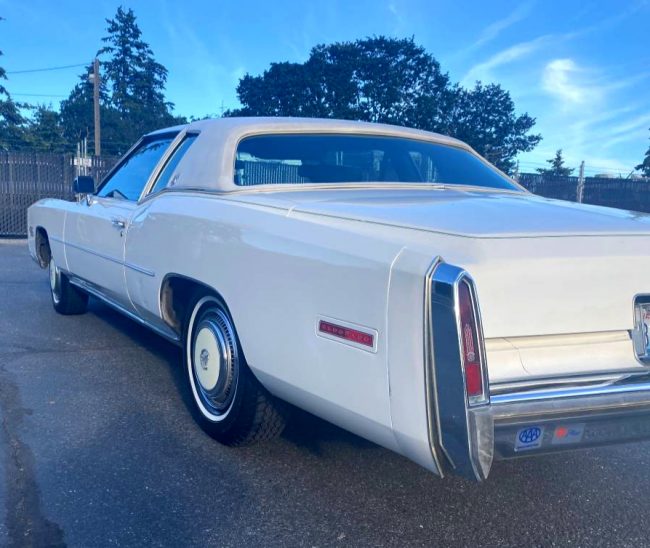
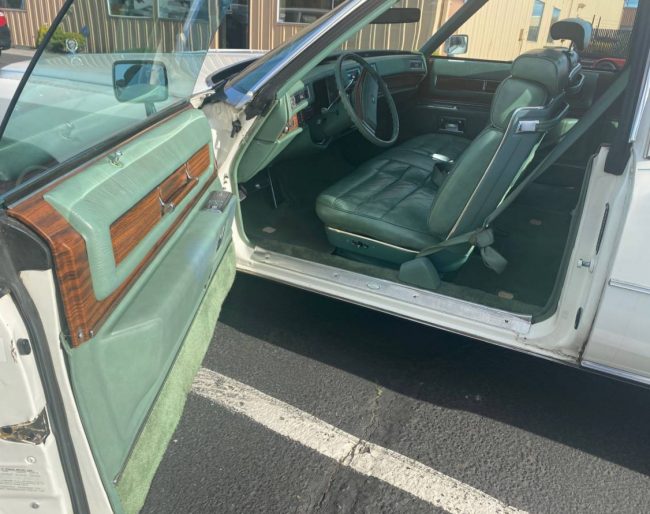
This one is available for immediate sale in Tacoma. With 63,000 miles and a $7900 ask, it seems very Klockau-tastic.
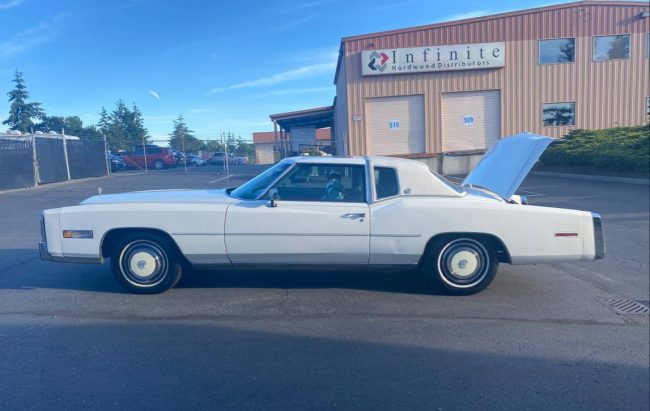
True, there’s a sheetmetal owie behind the driver’s door, but that’s a mere quibble.

But it does, unfortunately, have the optional fuel injection. In a nutshell, the standard carburetor was much more reliable.
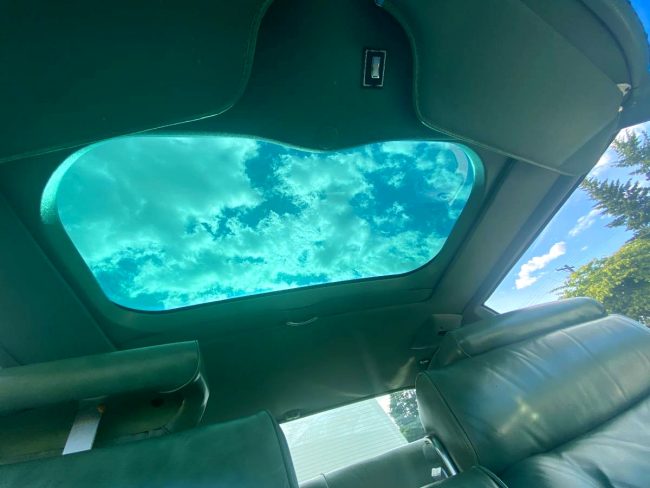
But, damn, it’s so pretty! Check out that green-tinted Astroroof. The Brougham Aquatic With Steve Zissou…
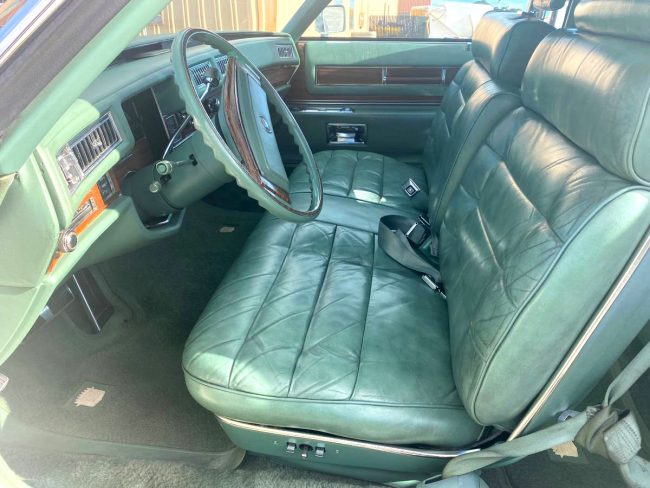
And the green leather is heavenly.
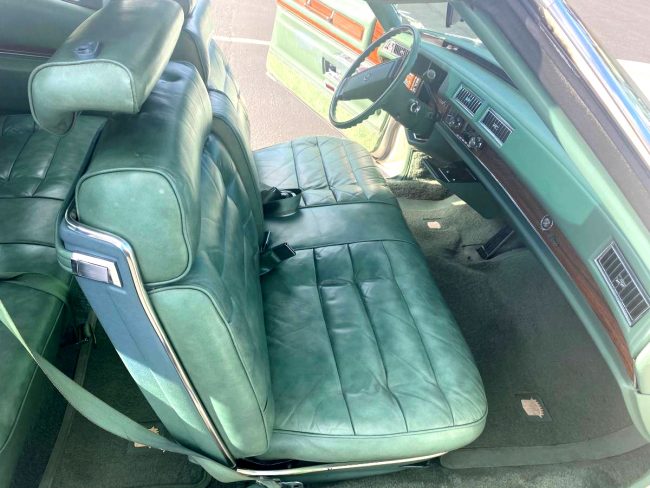
I really, really like green interiors. With the Cotillion White paint, it’s a great combo.
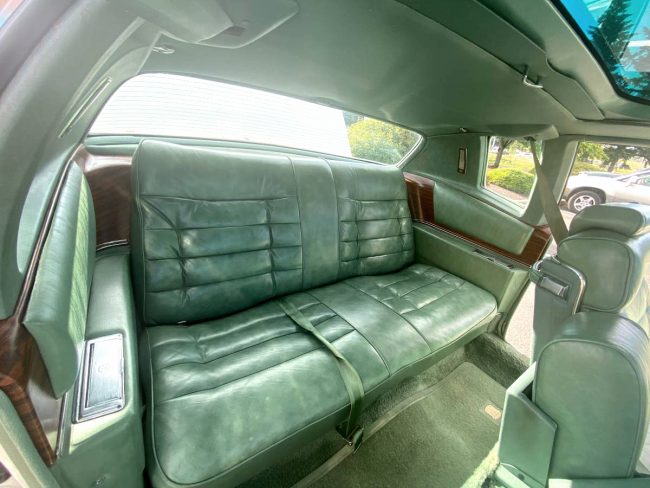
Just look at it. Awooga!
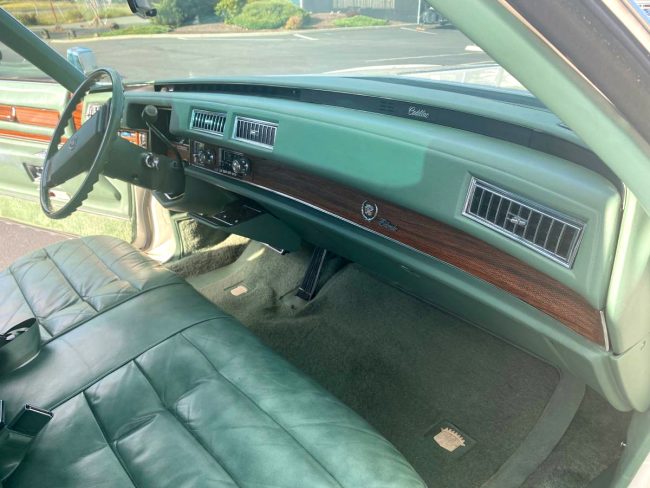
Just a pleasant change from the boring gray and black interiors on today’s supposed lux-cars.

This was the next to the last year for the truly giant, large and in charge rolling parade float Eldos.
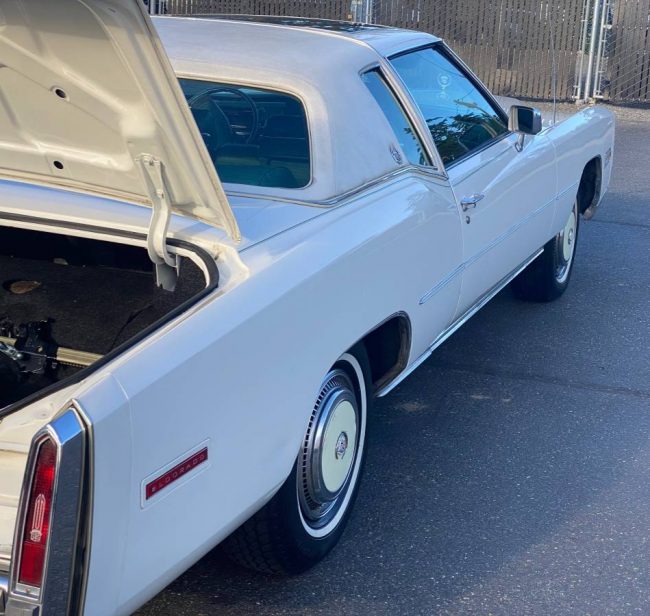
I did wonder why 90% of the photos had the trunk hanging open.
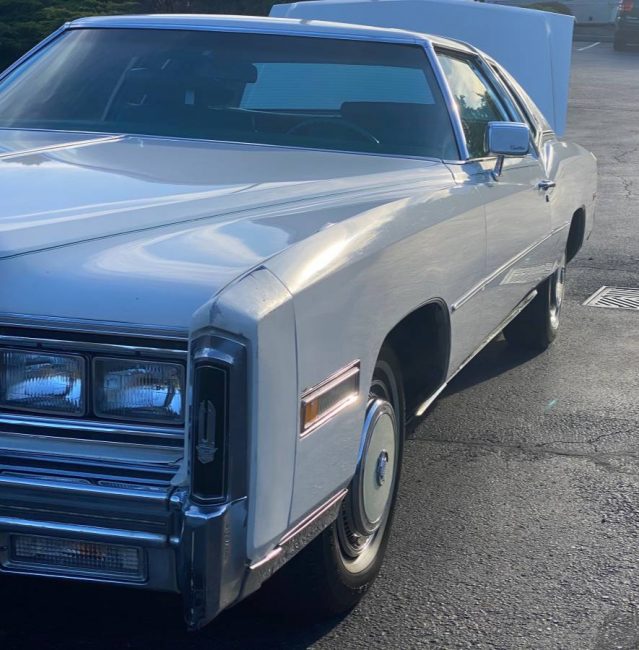
Maybe Paulie was taking Louie the Nose for a ride, and Louie jimmies the trunk and escaped, and Paulie gave chase. Then some dude took these pics because he likes ’70s Caddys, ha ha.

Anyway. A nice giant Caddy coupe, ifin you’re so inclined, and can deal with the nonexistent fuel injection parts!
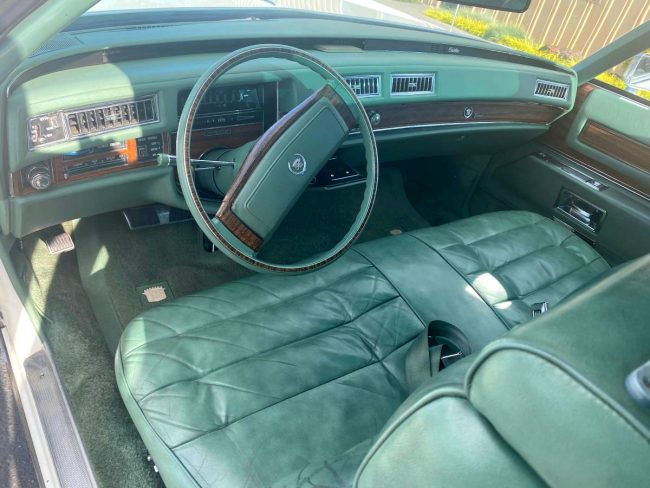







19 Comments
That is some effective woodgraining wrapping around the back seat. So many coupes even in the high end just have giant molded panels of hard plastic surrounding the well trimmed seat.
The 1977-78 had reverted to the 425 V8 from the earlier 500. I wonder absent any downsizing, what the benefits to economy and the penalty to acceleration. I know the FI added 15 horsepower above the carb, so benefited the first owner even if complicating the life of the fifth.
Backseats in coupes have taken a..ahem..backseat in appointments in recent years!
You didn’t have the amount of plood seen here in, say, an A/G-Body Cutlass Supreme, Monte, GP, or Regal, but you’d have comfortable armrests, seat-upholstery inserts, and perhaps an ashtray. Now, you’re lucky to have an armrest, all in plastic!
While looking up Regals and Montes for sale to jog my (mostly correct) recollection of how the back seats were appointed, I got some sticker shock! I would expect the ask for a Regal GN from, say, ‘84-‘87, to be in, perhaps, the high-$20s for a rough driver, up to the $40s for one in survivor condition, with GNXs into the six-digits for a perfect example. T-Types and other turbo-equipped cars (yes, I believe for at least a few years, and maybe all through the run, you could order a column-shifted, button-tufted Limited with the turbo—what Brougham-a-riffic, tire-melting fun! 😁) would go for substantially less.
Guess again! Apparently, the turbo-V6 is a license to print money! We’re talking ** T-Types ** in the $40s! Rough-but-restorable, $20s!!!
On the Turbo 3.8 Regal, the conversation starters should be the earliest with the two barrel carb. There also were 4 barrels early, but remember the early marketing was that the turbo was the answer for economy as well as performance and the turbo was a new answer strait from Buick’s engineers. Very similar to to how Ford promoted the Ecoboost turbos when they were first out.
I suspect late GNs have a big price advantage over say 442 Olds but they had the big power boost and the Lear Sieglar seat, a unique option. Defining the passage of time debate might be the relative values of 89 Trans Ams with the 350 V8 versus ones with the 3.8T from the end of that engines line.
Tom, absolutely fantastic.
Interesting that the first owner ordered the two most expensive options available: EFI and Astroroof which alone added approximately $2,000 to the sticker price, but did not check the box for the 50/50 split bench sea which had dual arm rest instead of a single. Anyway, if any of your readers want to know what original fender and rear quarter and rear bumper fillers look like, this car still has all the originals. However the fronts are on borrowed time, notice the discoloring at the top of the drivers side front fender filler, that is a sign that it is about to shatter, once they start to loose the paint that means the material is deterorating and will soon split and fall apart. However they were not made to last over 40 years so someone took good care of this car. Also, the wood grain is still in the steering wheel and that wood grain surround on the horn is still in one piece (that wood grain plastic part around the horn button is paper thin and tends to crack and fall apart on the 77-78 cars).
Overall a very well cared for car and like you I love the multude of interior colors to choose from on these cars, it is one of the things that makes them special. One final note, this is not a Biarritz which means that there is less of a rust issue with the vinyl top as the Eldorado Coupe tops were installed at the factory as opposed to the Biarritz padded vinyl top that were installed post production at ASC with little or not rustproofing.
JohnC, the 425 used the same block at the 500 and was in the same engine family, just smaller cylinders. As GM was making a token acknowledgement to fuel economy but it really did not make much difference. GM put the 425 in all models in 77-78 except for the Seville and it remained in the Deville/Fleetwood models in 79. The 425 was an outsanding motor.
Again, great car at a reasonable price.
So Lynne you mean taking care of the car meant that the body color plastic fillers could last over 40 years. Gosh that is going to break the heart of the hecklers because they really just hated the style and the people that it attracted. They had of course concocted this hypothesis that those that street parked in extreme temperature locales proofed that the car was of low quality and we should ignore the obvious advancement of a high powered but still front drive car. Remember this was a time that Hondas managed 60 horsepower from their CVCC engines but still managed to exhibit torque steer as per C/D.
I’ve seen cars with original ones but the really only survive on cars that were extremely well kept, they even rot on stored cars that weren’t driven, they probably could have been make a little more durable and they were on later cars, they don’t seem to rot off on newer cars like they did on 74-79 cars.
Yawn. Most chatbots are less predictable than you.
Have you ever actually owned a Cadillac? For as much as you talk supporting the domestic industry and complain about the people who don’t like American cars, it sure seems like when push comes to shove, you choose to spend Cadillac money on fake Saabs and Chinese Volvos instead.
Signed,
A Cadillac Owner
You mean I beat some chatbots. That means a lot coming from you Mr. Truckface
Your refusal to answer my question confirms your troll status.
No, never owned a Cadillac. By the time, (21st century) I was in the price range, Cadillacs were designed by people who may have been wellborn to meet affirmative action goals or HB1 utilization rate goals but were actively embarrassed by any pre 1993 Cadillac. That just wasn’t a problem at Saab or Volvo and only became a problem at Jaguar after 2008. Those designers would be part of the mob that would turn over, burn, and throw in the river a rolling statue like this Eldo. Their simple minds understand that it was not what they would have built and can sense what Eldo drivers would have thought of them.
This wasn’t even the problem at Buick were at least they were trying to make a real Buick off of some Opel or Holden platform. Notice that effort was met by one of the hosts here with a Buick “death watch”. I was offended when Bark did that but he was prescient because the mob will come for them.
John C.
I would like to recommend that if you have an opportunity next year (as the pandemic has cancelled all events this year) attend a Cadillac LaSalle Club event, the Grand National next year is in Albuquerque July 13-17, or better yet the CLC Museum and Research Center Concours September 23-26 in Michigan. You would have an opportunty to see some very well perserved Cadillacs as well as meet people that have a lot of knowledge about the brand. At last years Concours I talked to the designer of the 1971-1978 Eldorado and discussed its many great characteristics and its few short comings. He said that the engineering of the drive train was never short changed. However, he told me that many of the shortcomings that people that are more then happy to point out today were in fact the result of cost considerations. For example, the plastic wood tirm was originally designed to be real wood. Like wise the use of plastic chrome was a cost issue and others. In other words John trade off. Really, come meet some of us Cadillac guys and meet some fine examples of the Division….
Oh, one thing you should know about the engineering of the Eldorado drive line, it was use to power the 22, 24, and 26 foot GMC motor homes from 1975-1978. Pretty well engineered for an automotive drive line to be droped into a truck and motor right along. 🙂 🙂
I just want to add, the GMC Motorhome came in 23 and 26 foot lengths and was made from 1973-1978.
I was more curious about what happened to the rocker panel to the rear of “Body By Fischer” plate. Something fishy about that seam.
OMFG! I misspelled “Fisher Body!”
Time to turn in my “car guy” credentials, I guess! 🙄
To Jack, Mark, and the rest of the Dads out there, Happy Father’s Day!
Mom and Dad were convertible fanatics. When they heard the 76 Eldorado was going to be the last convertible, they hustled over to Jack Kent Cadillac and ordered one. I had the fiberglass tonneu cover instead of the vinyl. Looked sharp when installed, a pain to store otherwise. Hers was dark blue, with a light blue interior.
I think that was the Cadillac I drove my wife from the church to the reception in
As it happens, I’ve got one of those 70s Eldorados with the Bendix fuel injection. And it’s been sitting in my garage in pieces for two years while I rebuild that fuel system. Tom is only partly correct about parts availability: Nearly everything is available … but under some other listing. Parts catalogs are simply not accurate that far back. But the fuel filter is a Mustang part. The injectors are listed for the Seville’s 307cid small-block. Walbro will sell you a fuel pump that’s close enough.
It’s been an adventure. I believe, perhaps naively, that I’m through the worst of it and will have the car back on the road in time for a couple of show-and-shines this summer.
And oh, yes, the resin bumper fillers are disintegrating, even though the car has lived its entire life under a cover in a garage, and was only brought out for summertime runs to Dairy Queen and church. Those also are getting replaced, as soon as I can drive the car to the body shop.
I had mine reconstituted in sheet metal – front and back. Expensive but permanent.
Baconator,
If you have not already found out, the greatest weakness in the Bendix EFI system is the ECU. For some reason the engineers in the early 1970’s routed the power source for the in-line and in-tank fuel pumps though the ECU. As the fuel pumps age and draw more current it tends to burn up the connectors within the ECU. Bruce Roe who has become an expert on these systems has devised a workaround. See the link below:
http://forums.cadillaclasalleclub.org/index.php?PHPSESSID=a9d7aeb235e7a748063988deb54a4e75&topic=153100.0
The bad thing is that the system gives you know warning that it is about to fail due to excess draw and the associated heat. You can be driving along and the engine just stops because the fuel pumps are recieving no power. All most all the members of the Cadillac Club have implemented this bypass so that the power for the fuel pumps circumnavigates the ECU so that the problem is address. One good thing about the Bendix System is that the Motherboard and parts inside the ECU are so big that they can be worked on. I would recommend that if you have a friend that does automotive electrical work that you have the by-pass installed as per the drawing in the link above.
One last thing, O-Rings. replace your O-Rings on your injectors. The fuel system is under a very high PSI and a failure of an O-Ring will turn your car into a rolling fire ball. You do not want fuel spraying out onto a hot manifold at high pressure.
Again, these Bendix Syetems are really good and well made, it is just they are 40+ years old now and need to be maintained.
Best of luck with your Eldorado.
I find several things annoying about this late Seventies version of Cadillac’s so=called Personal Luxury car
1. Clumsy bench seat which belies the “personal” luxury moniker.Lincoln got it right. The Mark III Series came standard with a “Twin Comfort” front seat beginning way back in ’68/’69.
2.The rear seat is missing a center arm rest – which was de rigueur on Eldorados during the ’70s.
3. All that wrap around rear seat wood was little more than plasticized wall paper. The last real wood (laminate) was in the 1969 models. It comes across as chintzy and cheap on a car of this price range at the time.